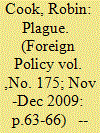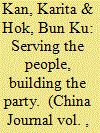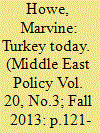| Srl | Item |
| 1 |
ID:
152614


|
|
|
|
|
| Summary/Abstract |
Early modern Siam is usually portrayed as a predominantly rural, peasant society. This picture is assumed from the worldwide trend of rural-to-urban transition, rather than from study of Siam itself. The available sources have a striking lack of any evidence on rural society. This article explores the possibility that this absence may reflect a real-world difference, not just perception. Unlike in temperate zones, enough food could be produced without dedicating the efforts of a majority of the population to agriculture. Rice could be grown by part-time ‘commuter’ agriculture, and other foods found by everyday hunting and gathering. Cultural preference based on the instinct for survival may have reinforced an affinity for urban residence. The scant data on Siam's demography suggest the majority of the population lived in urban places. Descriptions of the capital portray a commercial and industrial centre, capable of employing many in non-agricultural pursuits. The state systems for raising resources were tailored to an urban rather than a rural society. While the scarcity of data on early Siam makes any ‘proof’ impossible, the thesis that Siam was a predominantly urban society is worth exploring. From the early eighteenth century on, Siam was subject to a process of ‘ruralization’ that created the familiar peasant society that historians have projected back into the past.
|
|
|
|
|
|
|
|
|
|
|
|
|
|
|
|
| 2 |
ID:
083867


|
|
|
|
|
| Publication |
2008.
|
| Summary/Abstract |
This article looks at the Chinese state's community/shequ building effort to govern a more heterogeneous and mobile population in urban China so that a 'harmonious society' (hexie shehui) can be achieved. Shequ building initiatives move away from the governance model based on direct government and administrative control, and toward a new model of structured community self-governance. Within some communities, this new model has faced challenges that appear to arise from the new diversity of interests that characterize Chinese cities today. The article acknowledges that social complexity often begets organizational challenges for emerging shequ organizations; but it also suggests that the social simplification of individual shequ is a tendency that has wider negative social implications and needs itself to be resisted
|
|
|
|
|
|
|
|
|
|
|
|
|
|
|
|
| 3 |
ID:
030783


|
|
|
|
|
| Publication |
London, Radius, an imprint of century Hutchinson Limited, 1988.
|
| Description |
xii, 176p.hbk
|
| Standard Number |
0091732026
|
|
|
|
|
|
|
|
|
|
|
|
Copies: C:1/I:0,R:0,Q:0
Circulation
| Accession# | Call# | Current Location | Status | Policy | Location |
| 030455 | 947.0854/LEW 030455 | Main | On Shelf | General | |
|
|
|
|
| 4 |
ID:
091467


|
|
|
|
|
| Publication |
2009.
|
| Summary/Abstract |
Sometimes fiction can do more to change public opinion than nonfiction. It took Uption Sinclair's 1906 novel, The jungle, to awaken the public to the dangers of sausage and the meat-packing industry in general.
|
|
|
|
|
|
|
|
|
|
|
|
|
|
|
|
| 5 |
ID:
177963


|
|
|
|
|
| Summary/Abstract |
The reform era has been associated with the waning authority of the Chinese Communist Party in urban society. While existing studies have investigated the Party’s self-reinvention through the incorporation into its ranks of professional groups and the new socioeconomic elite, much less attention has been given to how the Party has rebuilt its presence in neighborhoods among urban residents and migrant communities. Drawing on a case study in Kunming, this article argues that the Party has sought to deepen its territorial reach and regain political relevance by emphasizing welfare provision and service delivery at the grassroots. The rise of service-centered Party-building has seen increased co-optation of previously independent social organizations as “partners” and “collaborators” in service provision. Enrolling NGOs enables the Party to both revamp its image as a paternalistic redistributor and regain its ability to mobilize the masses through appropriating the vocabulary of participation and volunteerism that social organizations espouse. If in co-opting the professional and business elite the Party has successfully fused Party authority with market power, at the urban grassroots it has appropriated social forces to reestablish its presence and bolster its legitimacy, with important implications for the autonomy and professionalism of NGOs.
|
|
|
|
|
|
|
|
|
|
|
|
|
|
|
|
| 6 |
ID:
126059


|
|
|